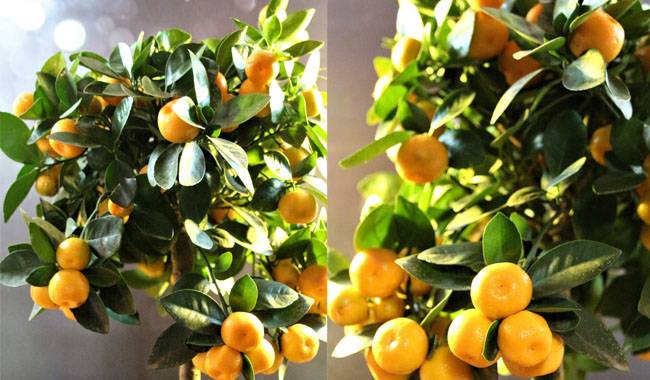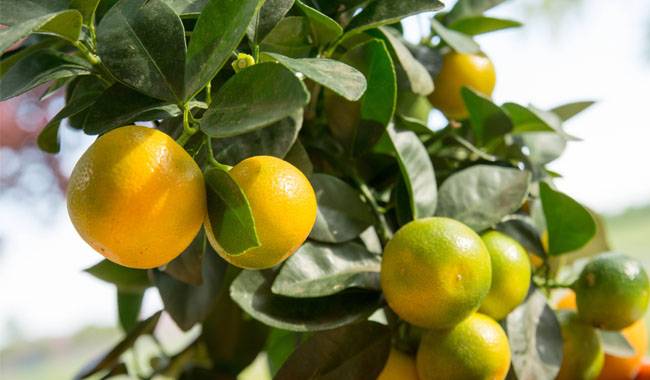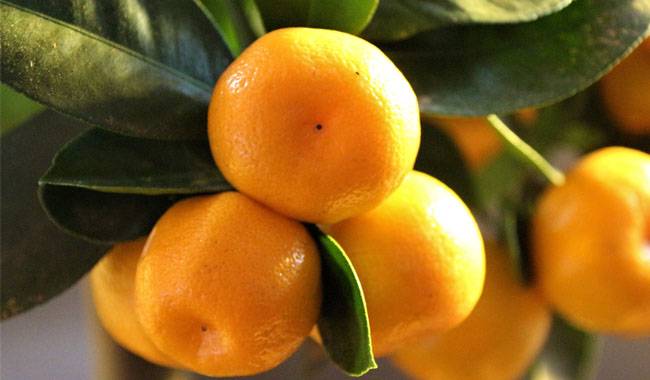
Calamansi (Calamondin) plants have always held a special place among houseplants. With their fragrant, lush flowers, distinctive leathery foliage, and long-awaited fruit, they have become timeless, ever-present classics for a reason. Unfortunately, not all Calamansi Plants have abundant fruit and compactness. Calamansi Plant is a hybrid variety with a dense and neat canopy that is scattered with miniature fruit. Of course, it also requires special conditions and care. Nevertheless, success is much easier compared to Calamansi Plant’s competitors. You will learn how to grow Calamansi (Calamondin) Plant in ThumbGarden’s article.
CALAMANSI PLANT DESCRIPTION
Small leaves, small fruits, compact size, and dense branching – Calamansi Plant (Citrus × microcarpa) is ideal for windowsills. Little is known under its botanical name citrofortunella (× Citrofortunella microcarpa, trade name: Calamansi), also known as calamondin, Philippine lime, or Philippine lemon. This visitor from Southeast Asia is a cross between Calamansi Plant and a kumquat, and it looks a lot like them.
Calamansi plants are compact Calamansi plants that do not exceed 16 feet (5 meters) even in nature. Today, they can appear both in bonsai form and as hanging plants, and not only to form shrubs or trees. Indoor Calamansi plants do not exceed 6.5 feet (2 m) even without formation, and even then are at a very respectable age. At the same time, they grow very fast and bear fruit very early – as soon as they reach 10 inches (25 cm).
The leaves are scented, smaller than citrus or kumquat, oval-shaped, and slightly pointed at the top. The dark green shade is lighter than the leaves of other citrus fruits and has a warmer, grassy look. This shine emphasizes the density of the leathery leaves. There are also Calamansi Plant varieties with variegated leaves.
The value of Calamondin is mainly reflected in its abundant flowering and fruiting. Starting in late spring, Calamansi Plant can continue to produce more and more flowers throughout the summer, simultaneously with the ripening of the fruit. Although the flowering period can be extended by several months, the fruiting period usually lasts from 6 to 9 months. Thus, the fruit lasts a long time on the branches.
The small white, fragrant, very delicate flowers bloom in small bunches of up to 4 or 1 at a time. Calamansi plants require hand pollination with soft spikes.
The fruits of Calamondin are round and no bigger than walnuts. They change color slowly and are striped, from dark green to yellow-orange. The outer skin is thin and sweet, with the same aroma as the bitter flesh. Surprisingly, Calamondin has a large number of seeds inside the fruit.
GROWING CONDITIONS OF INDOOR CALAMANSI PLANT

This hybrid is moisture-loving and sun-loving and can be grown as a house plant, winter garden, or garden pot. Calamansi Plant grows well only with controlled light, although it generally has lower light requirements than other citrus fruits.
Lighting and placement
Calamansi Plant does not tolerate direct sunlight. Therefore, for this citrus fruit, it is best to find as much bright light as possible in a soft, diffuse light regime.
As with other citrus fruits, the ideal place to grow Calamansi Plant remains a windowsill. Choosing east and west-facing windows are the most reliable choice, and south-facing windows with protective screens are also fine. On the north side, Calamansi Plant can feel uncomfortable even in summer. The optimal day length is 12 to 16 hours.
Calamansi Plant can lose its leaves if it is suddenly moved, so it is worth keeping its position in relation to the light source when rearranging or sanitary procedures. To ensure that the canopy develops evenly and does not fall over on one side, you need to turn the plant regularly, the canopy will be completely turned over within a year. Therefore, it is convenient to mark the pot to record the shifts.
Temperature and ventilation
The main advantage (and the secret of calamondin’s popularity) is its ability to flower and fruit even in relatively warm, overwintering conditions. Although the ideal temperature range for this calamansi plant in the resting stage (October to March) is 53-59 °F (12-15 °C), even in warm conditions of 60-64 °F (16-18 °C) over winter, the calamansi plant tolerates well and sends out flower buds. The main thing is that winter temperatures do not exceed 64 °F (18 °C) and that lighting and care of the plant are significantly adjusted.
During active growth, Calamansi Plant will prefer stable temperatures to extreme heat. Shrubs grow and flower very well in a temperature of 68-77 °F (20-25°C). Any sudden changes will affect the plant, so monitoring ventilation and being more rigorous with daily changes is best.
In summer, you can bring the Calamansi plant into the fresh air by placing it in a sheltered, semi-shaded area and taking measures to protect it from overheating.
CARING FOR CALAMANSI PLANT AT HOME

The most challenging aspect of growing Calamansi plants is their moisture-loving nature. Calamansi plants are intolerant of watering extremes and require constant care, reacting very strongly to mistakes.
Watering and humidity
During active growth, Calamansi Plant likes to be watered heavily. However, even in high summer, overuse is dangerous, as even a little humidity can lead to root rot. To avoid overwatering, you only need to do two things.
- Empty the tray immediately or after no more than 5 minutes.
- Check that the soil has not dried out between waterings (ideally about 1-2 inches (2.5-5 cm) from above).
However, it is also important to avoid drying out: a completely dry substrate will cause the leaves to turn yellow and fall off. The water should be soft and warm.
During the dormant period, reduce watering as guided by the conditions and reduce the humidity by about half.
This Calamansi (Calamondin) plant will only develop and flower properly when the humidity is about 70%; it will suffer in dry conditions, especially hot ones. Spraying the foliage is the preferred method of increasing humidity. Still, if the humidity in the room is severely off average, other measures such as a humidifier or a tray of wet kleenex must be used. The water should be soft and 10°F warmer than the substrate.
Feeding and Fertilizer Composition
Calamondins need additional fertilizer only when they are actively growing. The plant is susceptible to iron deficiency. For Calamansi Plant, it is best to use fertilizers specific for citrus or vegetable-fruit crops. Organic and compound fertilizers can be used as a last resort, alternating with 1-2 doses of chelated iron (or other monomers containing iron) during the summer.
Fertilize Calamansi Plant every 2 weeks with the standard dose specified by the manufacturer. It is better to stop fertilizing gradually.
Pruning and shaping of Calamansi Plant
Traditionally, the plant is shaped once a year in early spring before transplanting or starting active growth. Calamansi plant can be shaped as needed, keeping it compact or giving it a tighter shape. Branches should be cut no more than 2/3 of their length. any damage and wilted shoots should be cut back as soon as these become a problem.
Repotting, containers and substrates
Only young, unfertilized plants need to be transplanted annually. Instead, repot adult shrubs every 2 or 3 years as the root system adapts to the substrate, making sure to replace the top substrate layer in early spring.
For Calamansi Plant, use classic deeper containers that they are wide and have large drainage holes. If Calamansi Plant is to be grown as a bonsai, the most traditional model should also be chosen. The preferred container material is ceramic.
A high level of drainage is a prerequisite for the health of Calamansi Plant. Spread expanded clay pebbles or other materials on the bottom of the pot in layers 2 inches (5 cm) to ⅓ high. Any suitable substrate can be found in a nutrient-rich, loose soil mix. special substrates for Calamansi plants, fruit trees, or annuals are ideal, but you can also mix leafy bog soil and coarse sand in a 3:1:1 ratio or add a catalyst to the available substrate. Mildly acidic and neutral soils are also suitable.
The soil should not be broken up, and the Calamansi Plant should be carefully turned over to maintain the same level of immersion.
Diseases, pests and cultivation problems
If there are any signs of buds rapidly drying out or turning black, the affected part of the plant should be pruned urgently and removed from the pot to assess the condition of the roots. If the roots are unaffected, you can try to save the plant by correcting the condition. In addition to rot, Calamansi plants are quite resistant to rust and need to be started quickly with a systemic fungicide.
This hybrid cannot be called pest-resistant either. Mealybugs can cause a lot of trouble and require repeated insecticide treatments. Under unfavorable conditions, scale or spider mites, which prefer dry air, may colonize Calamondinas.
Propagation of Calamansi Plant
This Calamansi (Calamondin) plant shows remarkable flexibility in its formation and its ability to produce offspring. Calamansi plants reproduce mainly asexually, but in addition to rooting from top cuttings of 3 or 4 leaves usually under the canopy, new ones can be obtained by grafting onto more readily available orange bushes.







